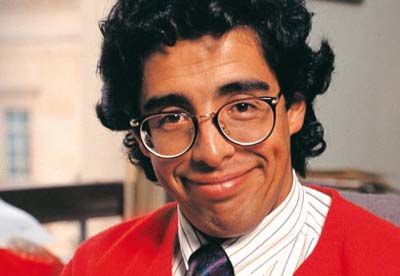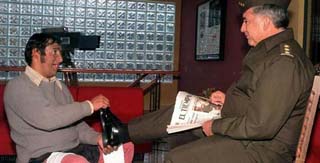Related postings | Washington, D.C., September 29, 2011 - Twelve years after the assassination of beloved Colombian journalist and political satirist Jaime Garzón, a newly-declassified State Department cable, published on the Web today by the National Security Archive (www.nsarchive.org), supports longstanding allegations that Colombian military officials ordered the killing. Written just days after the murder, the cable from the U.S. Embassy in Colombia says that Garzón “had been killed by paramilitaries in league with ‘loose cannon’ active or retired members of the security forces.”
One of Colombia's most popular television personalities, Garzón was also a high-profile advocate for government talks with leftist rebel groups when he was gunned down on August 13, 1999. Carlos Castaño, top leader of an illegal right-wing militia known as the United Self-Defense Forces of Colombia (AUC), was convicted in absentia of masterminding the plot in 2001 but was never brought to justice and is now presumed dead. Castaño remains the only individual ever sentenced in the case, though the involvement of Colombian security forces has long been suspected.
The document published today is among key evidence cited by lawyers representing Garzón's family who are seeking to hold the Colombian state responsible for his murder. Last month, human rights attorneys from the Colectivo de Abogados “José Alvear Restrepo” and the Comisión Colombiana de Juristas jointly requested a hearing on the Garzón case before the Inter-American Commission of Human Rights (IACHR).
Of particular interest in the newly-declassified cable is the revelation that retired general Rito Alejo del Río Rojas may have lied in a 2001 declaration before Colombian prosecutors when he denied that he had ever met Garzón. Quite the contrary, the embassy report says that Del Río “upbraided” Garzón when the two met to discuss his efforts to restart peace negotiations with the ELN guerrilla group. The embassy’s confidential source said that Garzón "came away from the meeting very troubled by the depths of the anger that Del Río vented."
“The general lied to the Prosecutor General’s office, and the question is why,” said Rafael Barrios, a lawyer from the Colectivo de Abogados.
Forced out of the military in 1999, Gen. Del Río is currently on trial for a separate murder charge and for collaboration with paramilitary death squads while he was commander of the Army’s 17th Brigade in Urabá. Former President Álvaro Uribe (who worked closely with Gen. Del Río while governor of Antioquia from 1995-1997) has been one of the general’sstaunchest supporters and was the keynote speaker at the general’s retirement ceremony.
The newly-released embassy cable on the Garzón killing adds to a growing body of declassified evidence pointing to Del Río’s “systematic” use of illegal paramilitary forces.
- A U.S. embassy “biographic note” from 1998 said that Del Río’s “systematic arming and equipping of aggressive regional paramilitaries” had been “pivotal” to the brigade’s success against guerrilla groups in the mid-1990s.
- One of the general’s deputies told U.S. military officials that paramilitary collaboration at the 17th Brigade “had gotten much worse under Del Río.”
- Another retired Colombian military officer told the embassy that Del Río was one of “the two most corrupt army officers in Colombia” and said that the general “told 17th Brigade personnel to cooperate with paramilitaries whenever Del Río was physically absent from the area.”
The cable backs up the testimony of former AUC paramilitary leaders who have also linked top military officials to the Garzón murder. Freddy Rendón Herrera (“El Alemán”) told a judicial panel that Castaño had authorized the Garzón slaying “at the specific request of a senior military leader of the time.” Another top paramilitary leader, Ever Veloza García (“HH”), told Colombian authorities that Castaño ordered the killing “as a favor to some friends in the National Army.”
Additional details linking Rendón’s “Elmer Cárdenas” bloc to the 17th Brigade were uncovered earlier this year in the Wikileaks material and published by El Espectador. The leaked embassy cable said that the 17th Brigade had illegally incorporated former members of Rendón’s paramilitary gang into a network of civilian informants (Red de Cooperantes) promoted by President Uribe. The official said his unit had been secretly authorized by the government to work with ex-members of the Elmer Cárdenas bloc and that they were “providing good information” on illegal armed groups in the conflictive Urabá region.
Urabá was the wellspring of the paramilitary AUC, which was responsible for thousands of killings and many of the country’s most egregious human rights atrocities. The U.S. State Department added the AUC to its official list of foreign terrorist organizations in 2001, in part due to its suspected role in the Garzón assassination.
Colombian prosecutors have also opened an investigation into charges that the country’s former top intelligence chief, José Miguel Narváez, was behind the killing.
The cable published today provides a chilling description of the killing, which occurred just a few blocks from the U.S. Embassy compound in Bogotá:
Jamie Garzon, 39, was killed in the classical Colombian "sicario" style: By gunmen riding double on a motorcycle while he sat in his car waiting for a traffic light to turn green. [Two lines redacted.] The gunmen had been following Garzon for at least several blocks. [Several words redacted] that their suspicions were raised when the rear rider took out a cloth and covered the motorcycle's license plate. Two blocks later, the motorcycle pulled even with Garzon's car, which was stopped at a light. The rider then pulled out a revolver and shot Garzon at point-blank range through the car window. Garzon died instantly as the result of at least three shots to the head and chest. Stay tuned for more from the National Security Archive as this important case develops in Colombia and in the Inter-American court system.
|



No comments:
Post a Comment